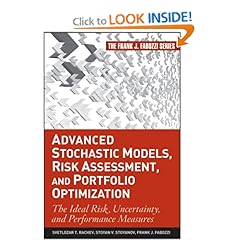This groundbreaking book extends traditional approaches of risk measurement and portfolio optimization by combining distributional models with risk or performance measures into one framework. Throughout these pages, the expert authors explain the fundamentals of probability metrics, outline new approaches to portfolio optimization, and discuss a variety of essential risk measures. Using numerous examples, they illustrate a range of applications to optimal portfolio choice and risk theory, as well as applications to the area of computational finance that may be useful to financial engineers.
From the Inside Flap
S ince the 1990s, significant progress has been made in developing the concept of a risk measure from both a theoretical and a practical viewpoint. This notion has evolved into a materially different form from the original idea behind traditional mean-variance analysis. As a consequence, the distinction between risk and uncertainty, which translates into a distinction between a risk measure and a dispersion measure, offers a new way of looking at the problem of optimal portfolio selection.
In Advanced Stochastic Models, Risk Assessment, and Portfolio Optimization, the authors assert that the ideas behind the concept of probability metrics can be borrowed and applied in the field of asset management in order to construct an ideal risk measure which would be "ideal" for a given optimal portfolio selection problem. They provide a basic introduction to the theory of probability metrics and the problem of optimal portfolio selection considered in the general context of risk and reward measures.
Generally, the theory of probability metrics studies the problem of measuring distances between random quantities. There are no limitations in the theory of probability metrics concerning the nature of the random quantities, which makes its methods fundamental and appealing. Actually, it is more appropriate to refer to the random quantities as random elements: they can be random variables, random vectors, random functions, or random elements of general spaces. In the context of financial applications, we can study the distance between two random stocks prices, or between vectors of financial variables building portfolios, or between entire yield curves that are much more complicated objects. The methods of the theory remain the same, no matter the nature of the random elements.
Using numerous illustrative examples, this book shows how probability metrics can be applied to a range of areas in finance, including: stochastic dominance orders, the construction of risk and dispersion measures, problems involving average value-at-risk and spectral risk measures in particular, reward-risk analysis, generalizing mean-variance analysis, benchmark tracking, and the construction of performance measures. For each chapter where more technical knowledge is necessary, an appendix is included. ![]()
See all Editorial Reviews
Product Details
|
Product Details
|




 全部版块
全部版块 我的主页
我的主页

 收藏
收藏







 扫码加好友,拉您进群
扫码加好友,拉您进群